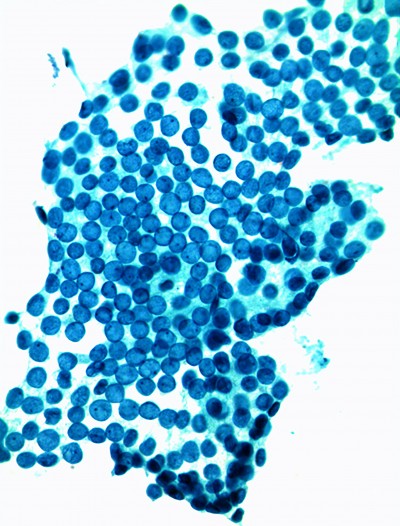News & Publications
HPV-Related Head & Neck Squamous Cell Carcinoma
January 1, 2013
By David C. Hoak, M.D.
In 2012, 49,260 new patients were diagnosed in the United States with cancer of the head and neck, and 11,480 patients died. A subset of these patients have squamous cell carcinomas of the head and neck (HNSCC) that are human papillomavirus (HPV) positive. These cancers differ molecularly from HPV-negative HNSCC with distinct molecular profiles. HPV-positive HNSCC patients tend to be younger and have a lower intake of tobacco and alcohol.

H&E staining in invasive SCC of the tonsil
HPV-positive HNSCC patients are often diagnosed at a late clinical stage with large cystic metastases to the lymph nodes in the neck. HPV-positive HNSCC usually begins in the oropharynx, especially the tonsils and the base of the tongue, and tends to be less differentiated histopathologically, meaning the tumors are less likely to look like oral squamous mucosa. However, the prognosis is better, regardless of the treatment regimen, for HPV-positive HNSCC.
The human papillomavirus tends to “home-in” or target the lymphoid-associated mucosa of the oropharynx, known as the palatine and lingual tonsils. Thus, most HPV-related tumors arise in these sites.
One viral genotype, HPV-16, causes most HPV-related HNSCC. HPV infection is the early, initiating event in HNSCC. High-risk oncogenic HPV subtypes have been shown to be capable of transforming oral epithelial cells through the viral oncoproteins E6 and E7 to become incorporated into the DNA of patients epithelial cells.

p16 expression in tonsillar invasive SCC
There is no single test that is currently accepted as the gold standard for clinical detection of HPV in HNSCC. Overexpression of p16 by immunohistochemistry (IHC) is a very good surrogate marker for HPV infection.
Recent studies reveal that tumor HPV status is an independent prognostic factor for overall survival and progression-free survival among patients with oropharyngeal squamous cell carcinomas. Therefore, it is important for the pathology laboratory to determine if squamous cell carcinoma of the base of the tongue, tonsil or metastasis to a neck lymph node is HPV associated.
At Incyte Diagnostics, we recommend testing for HPV with both p16 by IHC and HPV high-risk genotypes by in situ hybridization. Together, these tests have a sensitivity of 91.1%, a specificity of 94.2%, a positive predictive value of 96.4%, and a negative predictive value of 86.2%. 1

High-risk HPV by in situ hybridization in tonsillar invasive SCC
HPV positive HNSCC represents a growing number of head and neck cancers, in particular those located in the tonsils and/or base of the tongue. HPV HNSCC cancers are a distinct entity from tobacco and alcohol related head and neck cancers with a different set of risk factors, different tumor behavior, and different treatment options.
References:
1 Jordan RC et al. “Validation of Methods for Oropharyngeal Cancer HPV Status Determination in US Cooperative Group Trials,” Am J Surg Path: July 2012, Vol 36, p 945–954.
